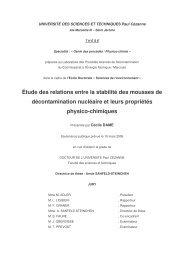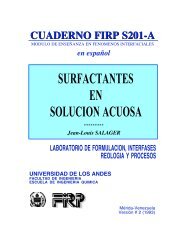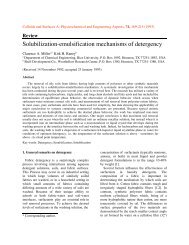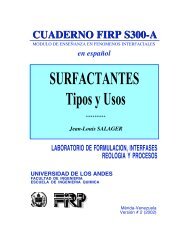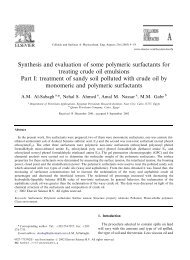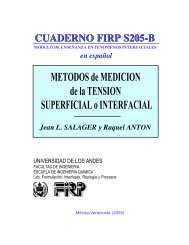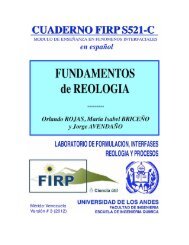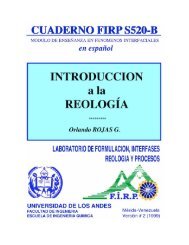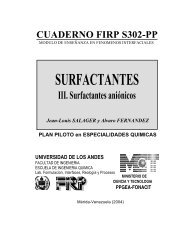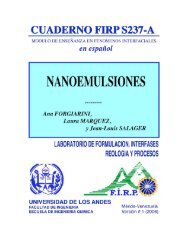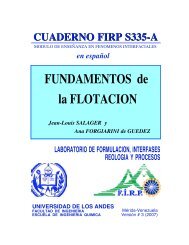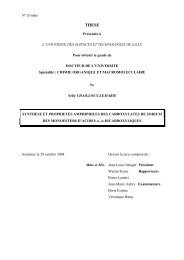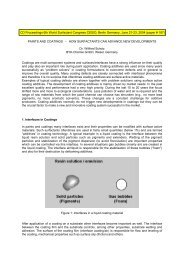Recent Trends Of Surfactants In The Fabric
Recent Trends Of Surfactants In The Fabric
Recent Trends Of Surfactants In The Fabric
You also want an ePaper? Increase the reach of your titles
YUMPU automatically turns print PDFs into web optimized ePapers that Google loves.
U.S.A.<br />
<strong>In</strong> the last ten years, liquid detergents in the United States have grown to their almost 70% market<br />
share and this volume has triggered changes in surfactants usage. Alkyl ether sulfate (AES)<br />
consumption is increasing more rapidly than any other surfactant including LAS.<br />
<strong>The</strong> trend in the past few years might be due to the federal legislation on low-water-use efficiency<br />
standards for residential washing machines. Where Stage 1 of this legislation is taking effect this year<br />
and Stage 2 will take effect in 2007 (1), two surfactants, methyl-branched alkyl sulfate (AS) and socalled<br />
modified LAS (MLAS), were developed and will meet the demands. Methyl-branched AS was<br />
developed to improve detergency and especially to dissolve powder detergents quickly. <strong>The</strong>se methylbranched<br />
surfactants will be discussed later.<br />
Japan<br />
Since the first concentrated powder detergent was launched in 1987 in Japan, concentrated powders<br />
have consistently played a leading role, especially for the past 10 years (FIGURE 1).<br />
Amount (1000 MT)<br />
800<br />
700<br />
600<br />
500<br />
400<br />
300<br />
200<br />
100<br />
0<br />
Traditional Powders<br />
Concentrated<br />
Powders<br />
Liquids<br />
Powders<br />
'91 '92 '93 '94 '95 '96 '97 '98 '99 '00 '01 '02 '03<br />
Note: Traditional & concentrated powders are combined from 2002.<br />
FIGURE 1. Laundry Detergent <strong>Trends</strong> - Production Volume in Japan (2)<br />
<strong>The</strong>re seems to have been almost no change in product form segments but surfactant-wise, a major<br />
change occurred around 2001. <strong>The</strong> new millennium saw a new generation of powder detergents<br />
suited to new washing machines developed to save time, water and use low mechanical force for less<br />
damage to clothes. This movement resulted in significant changes in the surfactant segments. While<br />
the amount of LAS decreased, the amount of alcohol ethoxylate (AE) increased when a new<br />
concentrated powder with quick solubility, intended to improve washing performance, was launched.<br />
An increased use of methyl ester sulfonate (MES) has been seen in Japan and this surfactant has<br />
also been introduced in North America.<br />
3. LAUNDRY DETERGENTS<br />
Two of today’s biggest issues facing the laundry detergent industry are the improvement of solubility of<br />
powder detergents and detergency at lower temperatures. <strong>The</strong> solubility of powders is regarded as the<br />
driving force behind the trend towards liquid detergents, most notably in the U.S. <strong>In</strong> 2001 and 2002,<br />
two new technological solutions were introduced to improve powder detergent solubility in the<br />
Japanese and the U.S. markets.<br />
<strong>The</strong> first is the development of new manufacturing processes to make quick-dissolving particles<br />
infused with higher contents of AE. AE is a nonionic surfactant that easily dissolves and shows good<br />
performance in cold water when compared to conventional anionic surfactants. However, AE with<br />
good detergency is usually liquid, so it is very difficult to incorporate a large amount of AE into<br />
powders. With the new manufacturing processes, the produced detergent particles are highly porous<br />
and can retain lots of liquid surfactant without adding any oil-absorbent materials (FIGURE 2) (3-5).



